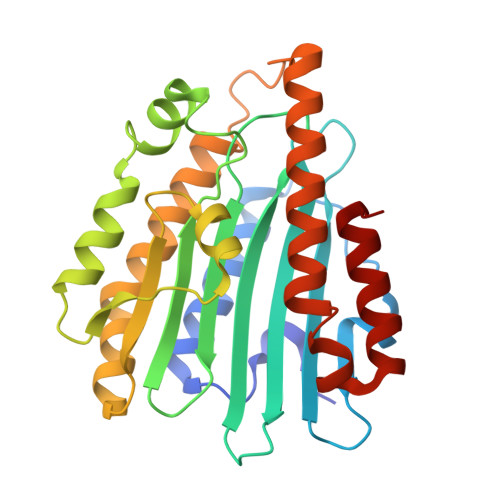Crystal structures of the substrate-bound forms of red chlorophyll catabolite reductase: implications for site-specific and stereospecific reaction
Sugishima, M., Okamoto, Y., Noguchi, M., Kohchi, T., Tamiaki, H., Fukuyama, K.(2010) J Mol Biol 402: 879-891
- PubMed: 20727901
- DOI: https://doi.org/10.1016/j.jmb.2010.08.021
- Primary Citation of Related Structures:
3AGA, 3AGB, 3AGC - PubMed Abstract:
Red chlorophyll catabolite reductase (RCCR) catalyzes the ferredoxin-dependent reduction of the C20/C1 double bond of red chlorophyll catabolite (RCC), the catabolic intermediate produced in chlorophyll degradation. The crystal structure of substrate-free Arabidopsis thaliana RCCR (AtRCCR) demonstrated that RCCR folds into a characteristic α/β/α sandwich, similar to that observed in the ferredoxin-dependent bilin reductase (FDBR) family. Here we have determined the crystal structures of RCC-bound AtRCCR, RCC-bound F218V AtRCCR, and substrate-free F218V AtRCCR, a mutant protein that produces the stereoisomer of primary fluorescent chlorophyll catabolites at the C1 position. RCC is bound to the pocket between the β-sheet and the C-terminal α-helices, as seen in substrate-bound FDBRs, but RCC binding to RCCR is much looser than substrate binding to FDBRs. The loose binding seems beneficial to the large conformational change in RCC upon reduction. Two conserved acidic residues, Glu154 and Asp291, sandwich the C20/C1 double bond of RCC, suggesting that these two residues are involved in site-specific reduction. The RCC in F218V AtRCCR rotates slightly compared with that in wild type to fill in the space generated by the substitution of Phe218 with valine. Concomitantly, the two carboxy groups of Glu154 and Asp291 move slightly away from the C20/C1 double bond. The geometrical arrangement of RCC and the carboxy groups of Glu154 and Asp291 in RCCR would appear to be essential for the stereospecificity of the RCCR reaction.
Organizational Affiliation:
Department of Medical Biochemistry, Kurume University School of Medicine, Fukuoka 830-0011, Japan. sugishima_masakazu@med.kurume-u.ac.jp















